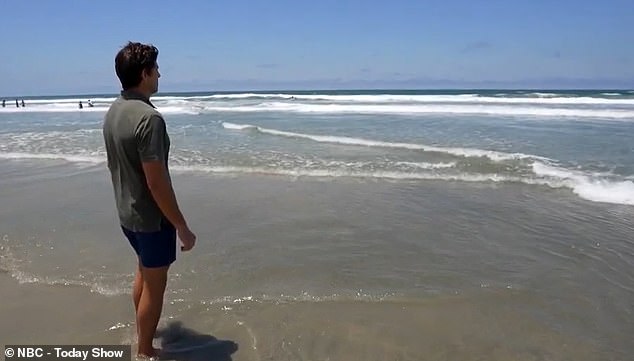Sea predator responsible for swimmer's horrific injuries off San Diego is revealed... as experts explain why attack could have been far worse
The sea predator responsible for a swimmer's horrific injuries off the coast of San Diego has been revealed.
Experts at the Shark Lab at California State Long Beach analyzed DNA from the wetsuit Caleb Adams was wearing when he was attacked on June 2, and the bite marks on the fabric.
They have since determined that Adams, 46, was bitten by a juvenile white shark that is believed to be around nine feet long and between six to eight years old, the San Diego Union-Tribune reports.
Fully grown white sharks can be up to 23 feet in length and live 45 to 70 years.
But it remains unclear what drew the shark to attack Adams as he was swimming with more than a dozen others about 100 yards off the shore of Del Mar, California.
He suffered major wounds to his torso, left arm and hand during the attack, with photos obtained by the Today Show showing deep gashes across his upper body.

Adams suffered major wounds to his torso, left arm and hand during the attack
Adams has since described feeling the shark grab at him, and his efforts to fight back.
'I tussled with the animal for what was seconds,' he told the Today Show.
'The second time I struck the animal, I felt a softer tissue. I'm going to speculate that that was in the shark's mouth and I have several cuts on my hands and wrist.'
Friends and lifeguards have said they heard Adams screaming, and used surfboards to help him back onto the shore.
'We heard some screaming. You could tell it was serious from the tone of the screams,' lifeguard Kevin Barrett told ABC7.
'You have to realize that you're swimming into an active shark attack and it's scary,' he added.
'But there's not really an alternative, and he's one of our own and we've got to bring him in.'
When they swam up to Adams, they saw he was bleeding profusely.
'We didn't know the extent of the injuries but there was definitely a lot of blood in the water,' Barrett said.

Caleb Adams, 46, was attacked by a juvenile white shark while swimming off the coast of Del Mar, California last month

Friends and lifeguards have recounted how they found him bleeding profusely and rushed to get him back onto the shore
Adams was then rushed to shore, where lifeguards and others provided first aid - applying a tourniquet to stop the bleeding before loading him into an ambulance to undergo surgery.
Throughout it all, a friend said, 'Caleb was amazingly calm.'
He is now continuing to recover from his wounds, and said he feels lucky that he survived.
'I think my wounds reflect that it was only a portion of what the shark could have done, so I can consider myself really lucky,' Adams told CBS 8 San Diego, adding that he is now only swimming in a pool.
It remains unclear whether the shark that bit Adams may still be in the area, which experts say is a haven for juvenile sharks.
Researchers have tagged about 40 sharks in the water between Del Mar/Solana Beach and Torrey Pines - where the predators may stay for weeks or months at a time.


A lifeguard and his friend were part of efforts to save Adams after realizing something was wrong
Chris Lowe, the director of the Shark Lab at Cal State Long Beach, said his team is now working to determine why sharks congregate at certain beaches, suggesting it could be that they like the water temperature, find plentiful fish and stingrays in the area or that they can avoid predators by staying in shallow waters.
'People should be aware it is an aggregation site and there are sharks out there,' he told the Union-Tribune.
Lowe's team is also set to analyze DNA from water samples taken after the June 2 attack to determine more about the individual sharks in the area.
'We have to sequence all the DNA and then try to reassemble it to see if we can identify [the shark] as an individual,' he said, noting that it could not be determined whether the shark that bit Adams was a male or female.

Adams has since described feeling the shark grab at him, and his efforts to fight back
Researchers could then use that DNA to try to build shark family trees, which could help scientists determine just how many sharks are in the water and how they might be related.
Shark attacks remain rare, as Lowe said they prefer to eat bottom-feeders over humans.
'We are definitely not on the menu, because if sharks liked to eat people, southern California would be a Costco for sharks, right?' he told CBS 8.
'We just don't see that.'
But last year, the US saw an uptick in unprovoked shark attacks and fatalities.
There were 36 recorded attacks across the country in 2023, accounting for more than half of the attacks across the globe.

It is unclear whether the shark that attacked Adams is still off the shore
Experts have told DailyMail.com they believe the increase in shark attacks is due to a mixture of a surplus of fish migrating to the coasts and environmental conditions, while others have said it's caused by America's efforts to clean up the ocean.
Many say that US conservation efforts to decrease pollution in the oceans has changed sharks' hunting behaviors, bringing them closer to water near land that was once unviable because it was so polluted.
In some states, like New York, conservation efforts to clean up rivers that flow into the ocean have reduced the amount of polluted and dirty water that reaches the sea, driving a rebound in marine life.
'Seeing sharks in our local ecosystem is extremely important, and it's a sign that the environment around us is healthy,' Chris Paparo, a shark expert at Stony Brook University in Long Island said in a series of Twitter videos.
But professors Oliver Shipley and Michael Frisk at the School of Marine and Atmospheric Sciences at Stony Brook told DailyMail.com that can't conclusively say there is one specific reason why the sharks are swimming so close to shore.

The number of shark attacks has driven the US to become the shark capital of the world, impacting states including Florida, New York and California
'This is not a cut-and-dry cause-and-effect scenario,' Shipley said.
'This is something that's extremely complex and we have to be really careful about attributing single things, like pollution, to why we may see more of certain animals in certain areas than we did before.'
Shipley said: 'I don't think that the number of incidents are higher in the US because it's anything to do with sharks being more aggressive here relative to other places, I think there are other demographic factors that might play into it.'
Florida and California see the most attacks in the US each year, likely caused by more people swimming in the water in those regions and the length of time people swim in the ocean during the year.
The International Shark Attack File revealed that great whites, tiger and bull sharks killed the majority of people in 2023, but the increased deaths are due to more people being in the ocean each year and a stronger emphasis placed on reporting bites and fatalities.

















































































































































































































































































































